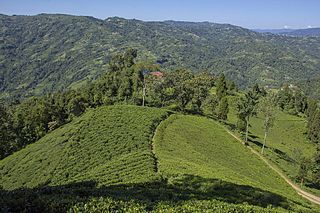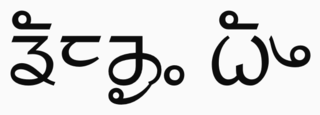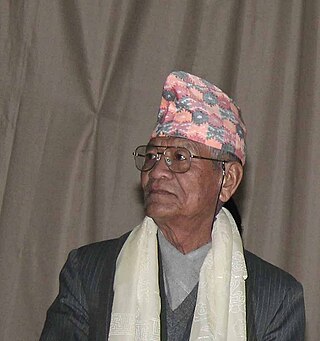The Limbu or Yakthung (endonym) are a Tibeto-Burman ethnolinguistic group indigenous to the Himalayan region of eastern Nepal, Sikkim, Assam, Nagaland, northern West Bengal, and western Bhutan.

Yakkha is an indigenous ethnic group from the Indian subcontinent, mainly in modern-day Nepal and present-day India. It is one of the descendants of Nepal's prehistoric Kirat dynasty. The Yakkha people are subsistence farmers who inhabit the lower Arun valley in eastern Nepal. They number only a few thousand and their language is nearly extinct.

The history of Sikkim begins with the indigenous Lepcha's contact with early Tibetan settlers. Historically, Sikkim was a sovereign Monarchical State in the eastern Himalayas. Later a protectorate of India followed by a merger with India and official recognition as a state of India. Lepchas were the main inhabitants as well as the Ruler of the land up to 1641. Lepchas are generally considered to be the first people, indigenous to Sikkim also includes Darjeeling.

Ilam district is one of 14 districts of Koshi Province of eastern Nepal. It is a Hill district and covers 1,703 km2 (658 sq mi). The 2011 census counted 290,254 inhabitants. The municipality of Ilam is the district headquarters and is about 600 km (370 mi) from Kathmandu.

Morang District is located in Koshi Province in eastern Nepal. It is an Outer Terai district, which borders Jhapa to the east, Dhankuta and Panchthar to the north, Sunsari to the west, and Bihar, India, to the south. Morang has one metropolitan city (Biratnagar), eight municipalities and eight rural municipalities. The total area of the district is 1,855 km2 (716 sq mi). The lowest elevation point is 60 meters and the highest is 2,410 meters above sea level. The headquarters of Morang is connected by the Koshi National Highway to the east–west Mahendra National Highway at Itahari, Sunsari. Morang is also connected to the Hill parts of the eastern region of Nepal. Morang is the core industrial sector for the eastern region of Nepal.

Sunsari District is one of 14 districts in Koshi province of eastern Nepal. The district is located in the eastern part of the Outer Terai and covers an area of 1,257 km2 (485 sq mi). According to the 2011 Nepal census, the population was 753,328. The district headquarters is located in Inaruwa.
Iman Xin Chemjong Limbu, or Iman Singh Chemjong Limbu; was a Limbu historian, writer, linguist, lexicographer, folklorist, and philosopher of Nepal. Chemjong devoted his entire life to studying and documenting various facets of Kirat Limbu tradition and culture at a time when such activities were frowned upon and even punished by the Nepalese ruling elite as being subversive and "anti-national". Chemjong's research into and publication of Kirant history and culture challenged perceptions of the Nepalese official doctrine that showcased Nepal as a Hindu cultural monolith devoid of alternative narratives.

Limbu is a Sino-Tibetan language spoken by the Limbu people of Nepal and Northeastern India as well as expatriate communities in Bhutan. The Limbu refer to themselves as Yakthung and their language as Yakthungpan. Yakthungpan has four main dialects: Phedape, Chhathare, Tambarkhole and Panthare dialects.

The Kirati people, also spelled as Kirant, are Sino-Tibetan ethnolinguistic groups and indigenous peoples of the Himalayas, mostly the Eastern Himalaya extending eastward from Nepal to Northeast India (predominantly in the Indian States of Sikkim and Darjeeling & Kalimpong hills of northern West Bengal
The Limbuwan–Gorkha War was a series of battles fought between the king of Gorkha and the rulers of various principalities of Limbuwan from 1771 to 1774 AD. After the conquest of Majh Kirat and Wallo Kirat by the Gorkhas, they invaded Limbuwan on two fronts. One front was in Chainpur and the second front was in Bijaypur. Bijaypur was the capital of the Morang Kingdom of Limbuwan Yakthung Laje.

Budha Subba Temple is a well known religious temple of the Nepali people. It is situated in Bijayapur of Dharan, Nepal. It is believed to fulfill the wishes and bring good luck to the people visiting there. According to Kirat historian Iman Singh Chemjong, Bijayapur was the capital of the then Limbuwan Kingdom of king Bijayanarayan Raya khebang. According to others, Bijayapur was named after King Bijaya.
History of Limbuwan is characterized by the close interaction of Limbuwan with its neighbours independent and semi-independent rule characterized by autonomy for most of its time.
Tye-Angsi Sirijanga Sing Thebe Limbu was an 18th-century Limbu scholar, educator, historian, linguist, leader, and philosopher of Limbuwan and Sikkim. He was formally known as Sirichongba and even more popularly known as "Sirijanga".
Chemjong is a Limbu surname. It is most common in Limbuwan, East Nepal, and Sikkim.
Yuma Sammang is the goddess of the Limbu community of Nepal. The deity Yuma Sammang also known as Ningwaphuma is the most important and popular among Yakthungs (Limbus) and worshiped in all occasion. Yuma is regarded as the mother by Yakthungs. Yuma Samyo or Yuma religion was very popular during Yet Hang age and Thibong Yakthung age.

Til Bikram Nembang Limbu, professionally known as Bairagi Kainla or Bairagi Kaila, is a Nepalese poet and litterateur. He has served as Chancellor of the Nepal Academy from 2009 to 2013. Part of his significant literary struggle was the Tesro Aayam movement. During the early 1960s, he, along with Ishwor Ballav and Indra Bahadur Rai, searched unexplored realms of Nepali literature and added a new dimension – the third dimension – to Nepalese literature.

Koshi Province is the autonomous easternmost province adopted on 20 September 2015 by Constitution of Nepal. The province is rich in natural resources, tourist attractions, recreational activities, and natural beauty. The province covers an area of 25,905 km2 (10,002 sq mi), about 17.5% of the country's total area. With the industrial city of Biratnagar as its capital, the province includes major eastern towns of Birtamod, Sundar Haraincha, Damak, Dharan, Itahari, Triyuga Municipality and Mechinagar, and the Mount Everest, Kangchenjunga and Ama Dablam. Koshi River, the largest river of the nation, forms the province's western boundary. Under the First-past-the-post voting system issued by the Constituency Delimitation Commission, Nepal, the province hosts 28 parliamentary seats and 56 provincial assembly seats.
Buddhi Karna Raya was the last Limbu overlord king of Limbuwan. He was killed by the forces of Gorkhali king Prithvi Narayan Shah in AD 1774. The Limbuwan lands where he was king or overlord king were between Saptakoshi River to Kankai River covering present day three districts: Sunsari, Morang and parts of Jhapa. After Buddhi Karna's death the later kings in Limbuwan acknowledged the overlordship of the Gurkha King. It was about the time of Buddhi Karna's death that the Gorkha Kingdom was transformed into Nepal. His death was connected with the Limbuwan–Gorkha war.

Sanman Chemjong, who writes under the pen name Swapnil Smriti is a Nepali writer from Panchthar, Nepal. He is best known for his literary movement Multicolourism along with Dharmendra Bikram Nembang. He elevated the realm of postmodern literature to its new height in Nepal with the publication of his first collection of poems entitled Rangai Rangako Bheer in 2005 AD.











